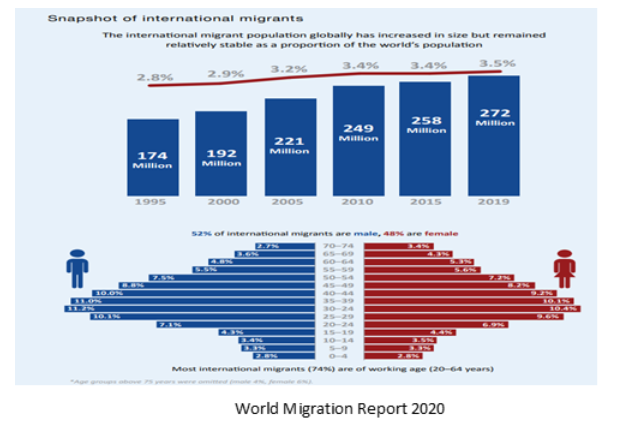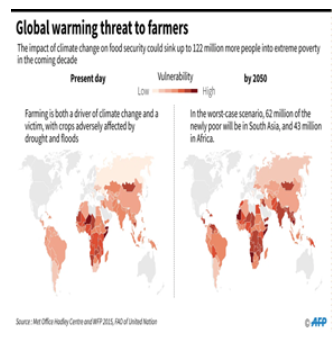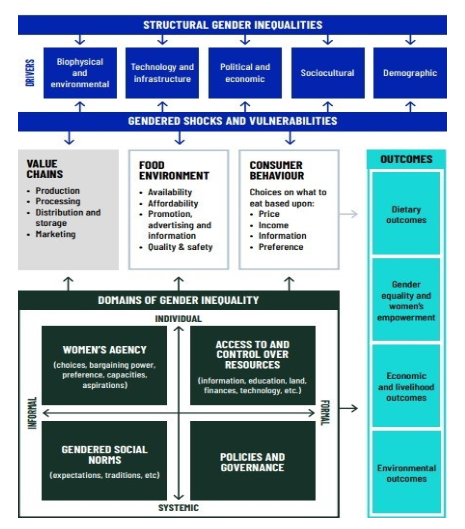24 Jan to 10 Feb, 2024
WILDLIFE LICENSING RULES 2024
Why in news : The central government recently introduced Wild Life (Protection) Licensing (Additional Matters for Consideration) Rules, 2024, amending the wildlife trade rules, 1983 resulting in significant changes in the licensing process and exclusions of certain species.
About :
Wildlife licensing rules in India, primarily governed by the Wildlife (Protection) Act, 1972, and its subsequent amendments, establish a regulatory framework for the protection and management of wildlife. These rules are crucial for regulating human interaction with wildlife, including the possession, breeding, transportation, and trade of wild animals and their by-products.
- Wildlife Protection Act, 1972 :
- It clearly defines the wild-life related terminology.
- The Act imposes a ban on the trade or commerce in scheduled animals.
- Some endangered plants like Beddome cycad, Blue Vanda, Ladies Slipper Orchid, Pitcher plant etc. Some animals are – Tiger, Sangai deer, Dugong, great Indian bustard.
- The Act provides for setting up of National Parks, Wildlife Sanctuaries etc.
- The constitution of Central Zoo Authority.
- The Act also provides the constitution of Indian Board of Wildlife (IBWL)
- It also sets up the National Tiger Conservation Authority.
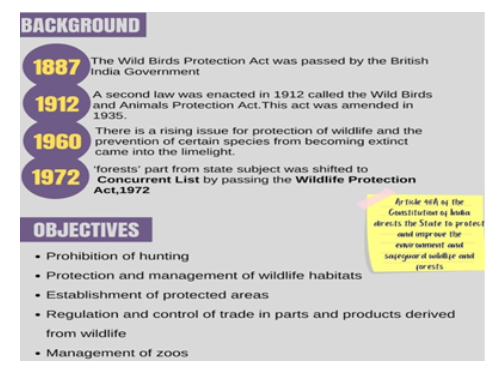
TYPES OF PROTECTED AREAS IN WILDLIFE PROTECTION ACT
- Sanctuaries : The State or Central Government can officially propose the establishment of a sanctuary for wildlife and environmental protection by issuing a notification. Subsequently, the government assesses and decides on the specific rights of individuals pertaining to the use of land within the designated sanctuary area.
- National Parks: The State or Central Government has the authority to designate an area, even if it's outside a sanctuary, as a national park to conserve and nurture wildlife and its habitat. The boundaries of a national park can only be modified by the State Government following a recommendation from the National Board for Wildlife. Furthermore, grazing and all other forms of human activities are strictly prohibited within national parks.
- Tiger reserves: The State Government, upon recommendation from the Tiger Conservation Authority, may designate specific areas as tiger reserves and is required to formulate a Tiger Conservation Plan for the management and protection of tigers in these areas.
- Conservation Reserves and Community Reserves : Protected areas introduced in the Wildlife (Protection) Amendment Act of 2003 serve as buffer zones and migration corridors, linking national parks, wildlife sanctuaries, and reserved/protected forests across India.
Schedules in WPA , 1972
- Schedules I and II of the Wildlife (Protection) Act pertain to endangered species, offering them absolute protection against hunting and exploitation, except under specific circumstances such as self-defense or disease control. Violations are severely penalized, as evidenced by high-profile cases like Salman Khan's conviction for hunting a black buck and the imprisonment of 16 individuals for tiger poaching. These stringent measures underscore the act's commitment to preserving endangered wildlife.
- Schedules III and IV of the Wildlife (Protection) Act encompass species that are not currently endangered or at risk of extinction, yet still require protection. While these schedules broadly mirror the provisions of Schedules I and II, the penalties for violations involving species listed under Schedules III and IV are comparatively less severe.
- Schedule V of the Wildlife (Protection) Act categorizes certain animals as vermin, such as mice, crows, monkeys, pigs, and bats. Hunting these animals requires a license from the District Forest Officer, who specifies permissible seasons and areas. Violations may result in the revocation of the hunting license.
- Schedule VI concerns with the cultivation and plant life and gives teeth to setting up more protected animal parks.
Prevention of Cruelty to Animals Act, 1960
- The Prevention of Cruelty to Animals Act, 1960, is a pioneering legislation aimed at protecting animals from human-inflicted pain and safeguarding their rights.
- The Act defines 'animals' broadly, encompassing all living creatures except humans, covering various animal forms.
- The Act mandates penalties for those inflicting unnecessary suffering or cruelty on animals and delineates forms of cruelty, exceptions, and conditions under which a suffering animal may be euthanized to prevent further agony.
- The Act mandates the creation of the Animal Welfare Board of India (AWBI).
Cosmetics Rules, 2020
- Following PETA India's recommendations, the Ministry of Health and Family Welfare implemented the revised Cosmetics Rules, 2020. These rules provide a modern regulatory framework for cosmetics' development, production, distribution, and importation, explicitly banning the import of cosmetics tested on animals.
- This positioned India as the first Asian country to prohibit both animal testing for cosmetics and their ingredients, as well as the import of such tested products, emphasizing that animal suffering cannot be justified by potential benefits of new cosmetic products.
Wildlife Protection Act 2022
- The central government has the authority to designate a Management Authority responsible for granting permits for the export or import of various specimens.
- Additionally, the central government has the power to regulate or even prohibit the import, trade, possession, or proliferation of invasive alien species, which are plant or animal species not native to India and could have adverse effects on wildlife and their habitats.
- Furthermore, the central government has the ability to declare a conservation reserve, typically serving as buffer zones, connectors, or migration corridors between established national parks and wildlife sanctuaries.
- The new legislation streamlines the existing system by reducing the number of schedules from six to four. Previously, these schedules covered protected plants (one), specially protected animals (four), and vermin species (one).
- The new act eliminates the schedule for vermin species, which includes small animals known for carrying diseases and damaging food sources, such as monkeys and Nilgai.
|
Reduces the number of schedules to Four |
|
|
Schedule I |
Animal species that will enjoy the highest level of protection |
|
Schedule II |
Animal species that will be subject to a lesser degree of protection |
|
Schedule III |
Protected Plant species |
|
Schedule IV |
Specimens listed in the Appendices under CITES (scheduled specimens) |
- Under the Act, the responsibility for overseeing, managing, and maintaining all sanctuaries within a state is vested in the Chief Wildlife Warden, who is appointed by the state government.
- Anyone in possession of live specimens of scheduled animals is required to obtain a registration certificate from the Management Authority.
- The act allows for the voluntary surrender of captive animals without compensation or subsequent authority over the surrendered animals.
- It's worth noting that there is an exception for 'live elephants,' allowing for commercial trade in elephants. This represents a departure from the previous Wildlife (Protection) Act of 1972, which explicitly prohibited the trade in wild animals, including both captive and wild elephants.
- For sanctuaries situated in Scheduled Areas, where the Forest Rights Act (FRA) of 2006 is applicable under the 5th Schedule, the management plan must be developed following consultations with the relevant Gram Sabha.
- States have the authority to declare areas adjacent to National Parks and Sanctuaries as Conservation Reserves, with the aim of safeguarding flora, fauna, and their habitats.
- Furthermore, the act increases penalties for violations, with higher fines of Rs 1,00,000 for general violations (up from Rs 25,000) and Rs 25,000 for violations involving specially protected animals (up from Rs 10,000).
Prevention of Cruelty (Animal Birth Control) Rules 2023
- The Prevention of Cruelty (Animal Birth Control) Rules 2023 rules was notified by the central government to address these challenges.
- The 2023 rules is under Prevention of Cruelty to Animal Act, 1960 and supersedes the Animal Birth Control (Dog) Rules, 2001.
- The 2023 regulations aim to address the limitations of Animal Birth Control (ABC) by establishing standardized procedures.
- These rules also offer guidance on managing conflicts between humans and stray dogs without relocating the dogs within an area. The responsibility for implementing ABC will primarily rest on the Animal Birth Control Monitoring Committees at the State, district, and municipality levels.
- Municipal Corporations are required to collaborate on the implementation of both ABC and the Anti Rabies Program. These programs should be carried out by organizations recognized by the Animal Welfare Board of India (AWBI) specifically for Animal Birth Control.
- The maintenance and population control of stray animals fall under the jurisdiction of local authorities, who will be held accountable for any violations and conflicts between animals and humans.
- The Rules also propose euthanasia for 'incurably ill and mortally wounded dogs' as determined by the Local Animal Birth Control Monitoring Committee. This should be carried out in a humane manner by a qualified veterinarian.
- Additionally, the Rules recommend establishing an Animal Help Centre where complaints about dog or cat bites can be reported.
- Resident Welfare Associations (RWAs) are encouraged to designate feed spots for dogs, ensuring they are located in areas less frequented by children and senior citizens.
Wild Life Licensing Rules 2024
The updated guidelines modify the regulations for trading in wildlife under the Wildlife Protection Act, 1972:
- Schedule I: The requirement for prior consultation with the Central Government remains for trading in species listed under Schedule I, which includes animals needing the highest level of protection (e.g., tigers, elephants, rhinos).
- Schedule II: The new guidelines ease restrictions for species in Schedule II, allowing for trading licenses to be granted without needing Central Government consultation or approval, a change from the previous mandate.
Factors Considered in Licensing
The new rules also specify the factors that the authorized officers must consider while granting licences, such as the capacity of the applicant, the source and manner of obtaining supplies, the number of existing licences in the area, and the implications on hunting or trade of the concerned wild animals.
Concerns Regarding the New Rules
- Exclusion of Schedule II Species
- The notification lacks explicit reasoning for the removal of licensing restrictions on Schedule II species, which include endangered mammals, birds, turtles, geckos, and snakes.
- This omission of detailed justification for the regulatory changes prompts concerns regarding the adequacy of protection for these important species.
- The absence of clear rationale underscores the need for a thorough examination of the revised regulations to confirm they meet conservation objectives without inadvertently diminishing the safeguarding of at-risk wildlife.
- Rationalization of Schedules in 2022:
- The Wildlife Protection Act 1972 underwent a restructuring through The Wild Life (Protection) Amendment Act, 2022, which modified how species were categorized across its schedules.
- Previously, species classification within the schedules was primarily determined by their endangerment levels.
- The 2022 amendments have potentially revised these criteria. There is speculation among experts about whether the removal of certain species from Schedule II reflects this reclassification process accurately and if there has been a genuine improvement in the populations of these species, warranting reduced protection measures.
Sections in the Indian Penal Code devoted to Animal Protection
- Section 428 prescribes penalties for killing, poisoning, maiming, or incapacitating an animal valued at ten rupees or more, with potential imprisonment up to two years, a fine, or both.
- Section 249 stipulates penalties for anyone who kills, poisons, maims, or incapacitates cattle (regardless of value) or any animal worth fifty rupees or more, imposing potential imprisonment up to five years, a fine, or both.
Judicial Interventions for the protection of animals: Important Case Laws
- State of Gujarat v. Mirzapur Moti Kureshi Kassab Jamat and Ors (2005):In the 2005 case State of Gujarat v. Mirzapur Moti Kureshi Kassab Jamat and Ors, the Supreme Court of India affirmed that Article 51A should be read in conjunction with Articles 48 and 48A, emphasizing a literal interpretation of these constitutional provisions to ensure their faithful implementation.
- Animal Welfare Board of India v. Nagaraja and Others (2014) : In the 2014 Animal Welfare Board of India v. Nagaraja case, the Supreme Court expanded the scope of Article 21 to recognize the legal right of every species to life and well-being.
- The Court redefined "life" in Article 21 to encompass a broader environmental context, including animal life, essential for human existence.
- This interpretation not only safeguards animal rights but also emphasizes that "life" implies more than mere survival, encompassing inherent value and adherence to ethical standards.
Conclusion
The 2024 amendments signify a crucial step in the evolution of wildlife trade rules in India. The relaxation of restrictions on Schedule II species , coupled with introduction of new licensing considerations ,reflects the government’s effort to balance conservation with the interest of stakeholders.
Where to use :
Paper II ( Geography optional ) : Wildlife and biodiversity
Paper III ( General Studies ) : Conventions, Acts and Rules of Environment
Source :
HEAT WAVES TO INTENSIFY IN MADAGASCAR, ONE OF EARTH’S RICHEST BIODIVERSITY HOTSPOTS
Why in news : Indian Ocean island experienced one of its hottest Octobers, with even the capital and highlands experiencing record heat.
About :
- In a glaring testament to the escalating climate crisis, Madagascar, the world's fourth-largest island and second-largest island country, has been grappling with an unseasonal and intense heatwave.
- The Indian Ocean state, renowned for its rich biodiversity, is experiencing climatic anomalies that are causing widespread concern among its populace.
Record-Breaking Temperatures
- In 2023 year, Madagascar recorded its hottest October, with temperatures soaring over 2.5°C above the average, a climatic extreme generally not witnessed until the months of December or January.
- This finding was part of a comprehensive study conducted by the World Weather Attribution (WWA). The capital city, Antananarivo, situated in the Madagascar highlands and home to over three million residents, bore the brunt of this unprecedented heat, experiencing some of the most intense and unusual temperatures.
Impact of Climate Change on Madagascar:
- The researchers concluded that the October heatwave and the observed minimum temperatures in Antananarivo were at least 100 times more probable due to the current climate change trajectory, driven primarily by the burning of fossil fuels.
The Perplexed Malagasy Population:
- Farmers in regions like the Amboasary Gare district and Manakambahiny Andrefana district, known for their agricultural prominence, expressed their concerns about the delayed rainfall and its impact on their crops. The dry and compact soil conditions have disrupted traditional farming practices and livelihoods.
- The Famine Early Warning Systems Network highlighted abnormally hot conditions in various parts of southern Africa, including Madagascar. This rise in temperature, especially in the highlands and the capital, is a departure from the usual climatic patterns observed in the region.
Vulnerability and Human Impact:
- With approximately 91% of the population living in poverty and 50% lacking access to clean water or electricity, the majority are deprived of basic amenities to cope with the heat. The inadequate housing conditions further exacerbate their vulnerability.
- The study emphasizes the need for significant investment in weather forecasting, early-warning systems, and heat planning to bolster resilience against the heat.
Health Implications
- The heatwave has not only affected the livelihoods but also posed serious health risks.
- The rising temperatures have expanded the habitat range of malaria-carrying mosquitos, leading to an increase in malaria cases in regions like Antananarivo, which were previously shielded by their cooler climates.
Conclusion:
Madagascar's struggle with the unprecedented October heatwave is a clear indicator of the intensifying climate crisis. The study underscores the necessity for immediate and concerted efforts to enhance community and governmental resilience against the impending climate threats. As Madagascar ranks alarmingly low on the Global Hunger Index, the urgency to address these climatic challenges and mitigate their impact on the vulnerable population cannot be overstated. The situation calls for a global acknowledgment of the crisis and a unified approach towards sustainable and resilient climate adaptation strategies.
Where to use ?
Paper I ( Geography Optional ) : Heat waves and rising temperature
Paper III ( General Studies ) : Global warming and its impacts
Source :
WORLD’S LARGEST DEEP SEA CORAL REEF MAPPED OFF THE UNITED STATES EAST COAST
Why in news : The reef is around 310 miles (500 km) long, extending from Florida to South Carolina. In some places, it is as wide as 68 miles (110 km).
About :
The newly found reef, spanning from Florida to South Carolina, is a significant underwater structure with a range of notable features:
Features of Newly Found Reef
- Vast Size and Extent: The reef's length is approximately 500 km, and at certain points, it can be as wide as 110 km. Its vast area makes it almost three times larger than Yellowstone National Park, highlighting its immense scale.
- Depth and Light Conditions: The reef is found at depths ranging from 200 to 1,000 meters.
- This depth range places it in regions beyond the penetration of sunlight, categorizing it as a deep-sea environment.
- This aspect is crucial because it suggests that the ecological dynamics, including the types of species and the biological processes in this reef, are likely to be significantly different from those in shallow-water reefs.
- Comparison with Other Reefs: While this newly found reef is significant for being one of the largest in deep water, it contrasts with the Great Barrier Reef, known as the largest coral reef system in shallow waters.
- The distinction between deep-water and shallow-water reef systems is crucial from an ecological and biological perspective, as the two environments offer vastly different conditions for marine life, influencing factors like light availability, water pressure, and the types of organisms that can thrive.
- Potential for Further Discoveries: A scientist's mention of the possibility of discovering even larger deep-sea reefs in the future is intriguing. This statement is supported by the fact that only about 25% of the world's ocean floor has been thoroughly mapped with high resolution.
- The vast unexplored areas of the ocean floor hold the potential for numerous other significant discoveries, which could offer more insights into marine biodiversity, geological structures, and potentially unknown biological and ecological processes.
Difference Between Deep and Shallow Water Coral Reef
|
SPECIFICATIONS |
SHALLOW WATER |
DEEP WATER |
|
Appearance |
Brown & Green |
White |
|
Diversity |
High |
Low |
|
Food |
Rely on Photosynthetic algae |
Feed on small plankton or available organic material |
|
Habitats |
Provides to sponges, crabs , etc |
Provides to sharks, swordfish , Octopus etc |
|
Type of Structure |
Rock Life |
Groves in the form of feathers, trees , etc |
|
Growth process |
Require Sunlight |
Dont require Sunlight |
|
Distribution |
Less coverage of ocean floor |
Larger coverage of ocean floor |
|
Challenges |
Climate change , Disturbance from oil and gas drilling . |
Climate change , Disturbance from oil and gas drilling |

Where to use :
Paper I ( Geography Optional ) : Coral reefs
Paper II ( Geography optional ) : Biodiversity
Paper III (General Studies ): Environment and wildlife, flora and fauna.
Source :
Rocks Glaciers
Rocks Glaciers : Rock glaciers are a type of landform that consists of a mixture of rock fragments and ice. Rock glaciers typically form in mountainous regions where there is a combination of permafrost, rock debris, and ice.
Thermokarst
Thermokarst : It is a type of terrain that is characterized by irregular surfaces of marshy hollows and small hummocks (ridges), formed by the thawing of ice-rich permafrost. The active rock glaciers could lead to the formation of thermokarst features, such as ponds or lakes, that could alter the hydrology, ecology, and carbon cycle of the region.
Globally Important Agricultural Heritage systems
Globally Important Agricultural Heritage systems : These are outstanding landscapes of aesthetic beauty that combine agricultural biodiversity, resilient ecosystems and a valuable cultural heritage. Located in specific sites around the world, they sustainably provide multiple goods and services, food and livelihood security for millions of small-scale farmers.
Acid Mine Drainage (AMD)
Acid Mine Drainage (AMD) : AMD occurs when sulfide minerals in mined rocks are exposed to air and water, resulting in the production of sulfuric acid. This acid can contaminate rivers, streams, and groundwater, posing a significant threat to aquatic life and ecosystems. Acid mine drainage (AMD) is one of the largest repercussions of mining on water resources. It is a risk associated with all kinds of hardrock mines for extraction of useful metals and a significant number of coal mines suffer from acid mine drainage.
Zero Shadow Day - Edukemy Current Affairs
Zero Shadow Day : Zero Shadow Day is a celestial phenomenon wherein vertical objects won't have any shadow for brief period of time. Zero Shadow Day occurs when the Sun will be directly overhead at local noon, and hence any vertical object will cast no shadow. This happens for places between the Tropic of Capricorn and Arctic Circle.
TEMPERATURE INVERSION IN ST. LOUIS METROPOLITAN AREA ( MISSOURI- ILLIONIS )
- Temperature inversion predominantly occurs during winter, particularly at night and in the early morning.
- Atmospheric stability forms a barrier that impedes the dispersion of PM 2.5 particles, consequently deteriorating the Air Quality Index. This phenomenon results in the formation of a pollution dome.
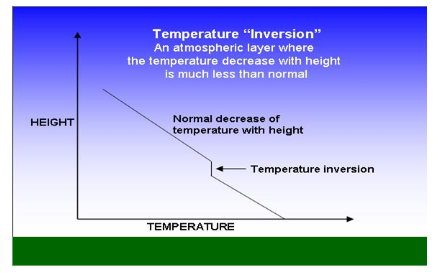
Where to use :
Paper I ( Geography Optional ) : Temperature Inversion and Pollution dome
Places in News - 10 February 2024
1. Mulugu
Why in news : The recent floods in the Mulugu district of Telangana has led to a fresh discovery of paleolithic quartzite tools
- It is a town in state of Telangana and was formed in 2019 after Jayashankar Bhupalpally district was split.
- Mulugu has a semi-tropical climate, where the people and its surroundings are pleasant and enjoyable.
- The hand axes were found in the stream between Gurrevula and Bhupatipuram villages in Mulugu district.
- Approx : Warangal
2. Bramsar Lake
Why in news : Recently rock glaciers, have been found near Bramsar lake in the Himalayas
- It lies in the Kulgam district of Kashmir valley at the northern foothills of Brama Sakli peaks.
- Bramsar lake is situated at the foot hills of Mt Brahmasakli.
- The water of Bramsar looks black due to the shadow of peaks falling over it. Above this lakes lies small glacial water bodies which are now big enough and possess a great threat of GLOF.
- Approx : Kishtwar
3. Kudankulam
Why in news : Recently India and Russia inked agreements linked to the construction of new reactors at the Kudankulam site in Tamil Nadu.
- It is a town in the Tirunelveli district in Tamil Nadu, India.
- It is also the location of hundreds of windmills used for power generation, eight of which are on the grounds of the nuclear plant.
- Approx : Kanyakumari
4. Pampore
Why in news : Recently there has been decline in the production of Saffron in Pampore region of Kashmir.
- Pampore is a town in Jammu and Kashmir, India, known for its saffron fields.
- It's located on the eastern side of the Jhelum River, about 14 km south of Srinagar.
- Pampore is known as the "Saffron Capital of India".
- It is also known as Pampar or Panpar in Kashmiri
- Approx : Srinagar
5. Kishanpur Wild life sanctuary
Why in news : Recently sanctuary reopened again with reduced tariff.
- It is a part of the Dudhwa Tiger Reserve near Mailani in Uttar Pradesh, India.
- The sanctuary is covered with a dense deciduous forest of sal, teak and jamun.
- It is contiguous with with Pilibhit Tiger Reserve and near the Nepal border in Indo -Tibetan region.
- Approx . Lakhimpur Kheri
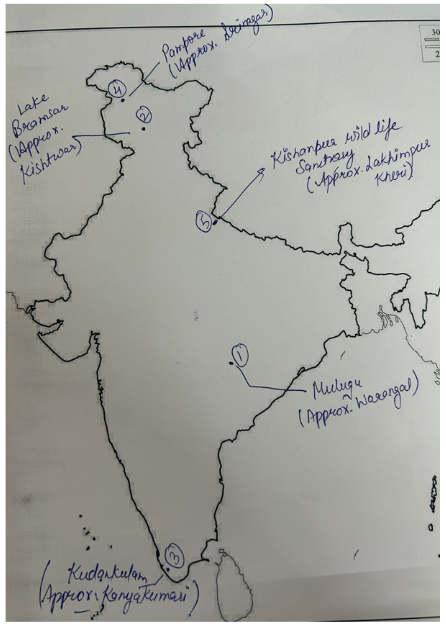
Fortnightly KOSMOS MCQ Practice
Q1. Statement-I: India is acknowledged as the principal worldwide producer of high-quality saffron, accounting for 95% of the global production of this spice.
Statement-II: The Pampore area in India, often referred to as Kashmir's Saffron Bowl, is the primary source of the country's saffron production.
Which one of the following is correct in respect of the above statements?
- Both Statement-I and Statement-II are correct and Statement-II is the correct explanation for Statement I
- Both Statement-I and Statement-II are correct and Statement-II is not the correct explanation for Statement-I
- Statement-I is correct but Statement-II is incorrect ·
- Statement I is incorrect but Statement-II is correct
Q2. With reference to ‘Thermokarst’, consider the following statements :
- This terrain is distinguished by an uneven landscape with swampy depressions and minor mounds.
- The Batagaika crater, a manifestation of thermokarst, holds the title of the largest permafrost crater globally.
- The dynamics of rock glaciers might result in the emergence of thermokarst characteristics.
How many of the above statements are not correct?
- Only one
- Only two
- All three
- None
Q3. Consider the following statements regarding Jhelum river :
- Its source is located in Tibet, close to Lake Mansarovar.
- This river is a subsidiary of the Indus River system.
- The Kishenganga River serves as its significant tributary.
Which of the statements given above is/are correct?
- 1 and 2 only
- 2 and 3 only
- 1 and 3 only
- 1, 2 and 3
Q4. With reference to the Darjeeling Zoo, consider the following statements:
- The Darjeeling Zoo is noted for hosting India's sole conservation breeding initiative for snow leopards.
- It stands as the most expansive zoo in India situated at high altitudes.
Which of the following statements given above is/are correct?
- 1 only
- 2 only
- Both 1 and 2
- Neither 1 nor 2
Q5. Consider the following statements:
- The Eucalyptus snout beetle, a leaf-eating pest, is native to Canada.
- This beetle has the potential to inflict damage across extensive regions due to its significant ability to fly.
Which of the following statements given above is/are correct?
- 1 only
- 2 only
- Both 1 and 2
- Neither 1 nor 2
Q6. Consider the following statements:
- The Ministry of Environment, Forest, and Climate Change declared the consolidation of Project Tiger (PT) and Project Elephant into a unified initiative named Project Tiger and Elephant (PTE).
- The 2006 amendment to the Wildlife Protection Act did not restrict the allocation of forests designated for tigers to development endeavors.
- Initiated in 1973, Project Tiger is a significant wildlife preservation endeavor in India.
How many of the statements given above are correct?
- Only one
- Only two
- All three
- None
Q7. With reference to Lentils, consider the following statements:
- Lentils, belonging to the legume family, feature flat, disc-shaped seeds and are characterized by bushy, annual plants with a compact height and flowers that are self-pollinating.
- As a rainfed crop, lentils flourish in cooler conditions during the vegetative growth phase and require warmer temperatures as they reach maturity, usually grown during the rabi season.
- The Bundelkhand area, spanning across Uttar Pradesh and Madhya Pradesh, is recognized as a major lentil-producing hub, accounting for approximately 25% of the nation's total lentil output.
How many of the statements given above are not correct?
- Only one
- Only two
- All three
- None
Q8. Consider the following statements :
- The Raxaul-Parwanipur, Kushaha-Kataiya, and New Nautanwa-Mainahiya transmission lines are the trio of newly opened cross-border electrical links between India and Bangladesh.
- Among its neighboring countries, India shares its most extended border with Bangladesh, followed by Nepal.
- India stands as Nepal's foremost trading ally and the primary contributor of foreign investments.
How many of the statements given above are correct?
- Only One
- Only Two
- All Three
- None
Q9. Consider the following statements regarding the Bhil Tribe:
- This group represents the most populous tribal community in Odisha.
- They have gained recognition for their exceptional proficiency in archery and adeptness in sculpture.
Which of the statements given above is/are correct?
- Only 1
- Only 2
- Both 1 and 2
- Neither 1 nor 2
Q10. Which of the following features is NOT typically associated with Western Disturbances?
- Extensive snowfall across the Himalayan region.
- Precipitation and thunderous storms in the lowland areas.
- Significant decline in temperature, particularly nocturnal, throughout Northern India.
- Development of tropical cyclones.
Q11. Consider the following statements :
- The saltwater crocodile holds the title of the largest among crocodilian species and ranks as the world's second-largest reptile.
- Bhitarkanika and Sundarbans, along with the Andaman and Nicobar Islands, are considered the three primary habitats for saltwater crocodiles.
Which of the statements given above is/are correct?
- Only 1
- Only 2
- Both 1 and 2
- Neither 1 nor 2
Q12. Consider the following statements regarding major and minor ports :
- The New Mangalore port stands as a significant port in India.
- All minor ports operate under the governance of the Indian Port Act, 1908, with ownership and administration shared between State and Central Governments.
Which of the statements given above is/are correct?
- 1 only
- 2 only
- Both 1 and 2
- Neither 1 nor 2
Q13. Which among the following is a part of the Lithium triangle along with Argentina and Chile?
- Brazil
- Columbia
- Bolivia
- Australia
Q14. Consider the following pairs:
Region Country
- Sistan Province (a). Iran
- Balochistan (b). Pakistan
- Marib (c ). Afghanistan
Which of the pairs given above is/are correctly matched?
- 1 only
- 1 and 2 only
- 2 and 3 only
- 1, 2 and 3
Q15. Consider the following statements:
- The most extensive deep-sea coral reef identified is situated along the Pacific Ocean's coastline.
- Situated off the northeastern coast of Australia, the Great Barrier Reef is recognized as the largest coral reef system in shallow waters.
Which of the statements given above is/are correct?
- Only 1
- Only 2
- Both 1 and 2
- Neither 1 nor 2
Share the article
Get Latest Updates on Offers, Event dates, and free Mentorship sessions.

Get in touch with our Expert Academic Counsellors 👋
FAQs
Geography Current Affairs focuses on the contemporary issues, events, and developments in the field of geography. It covers recent geographical phenomena, environmental changes, geopolitical shifts, and related news. This differs from regular geography studies which may focus more on foundational concepts, historical contexts, and theoretical frameworks.
Updates are provided regularly to ensure that subscribers stay informed about the latest developments in geography. Typically, updates are provided on a fortnightly basis, depending on the frequency of significant events and changes in the field.
Absolutely. Geography Current Affairs serves as a valuable resource not only for Geography optional but also for GS papers, especially GS Paper 1 (covering Indian Heritage and Culture, History, and Geography of the World and Society) and GS Paper 3 (covering Technology, Economic Development, Biodiversity, Environment, Security, and Disaster Management). It aids in building a holistic understanding of various topics and strengthens answer-writing skills by incorporating contemporary examples and perspectives.
Geography Current Affairs holds immense importance for UPSC preparation, particularly for aspirants opting for Geography optional. It helps candidates stay updated with the latest developments, geographical phenomena, environmental issues, and geopolitical shifts worldwide, aligning them with the dynamic nature of the subject as tested in the UPSC examinations.


